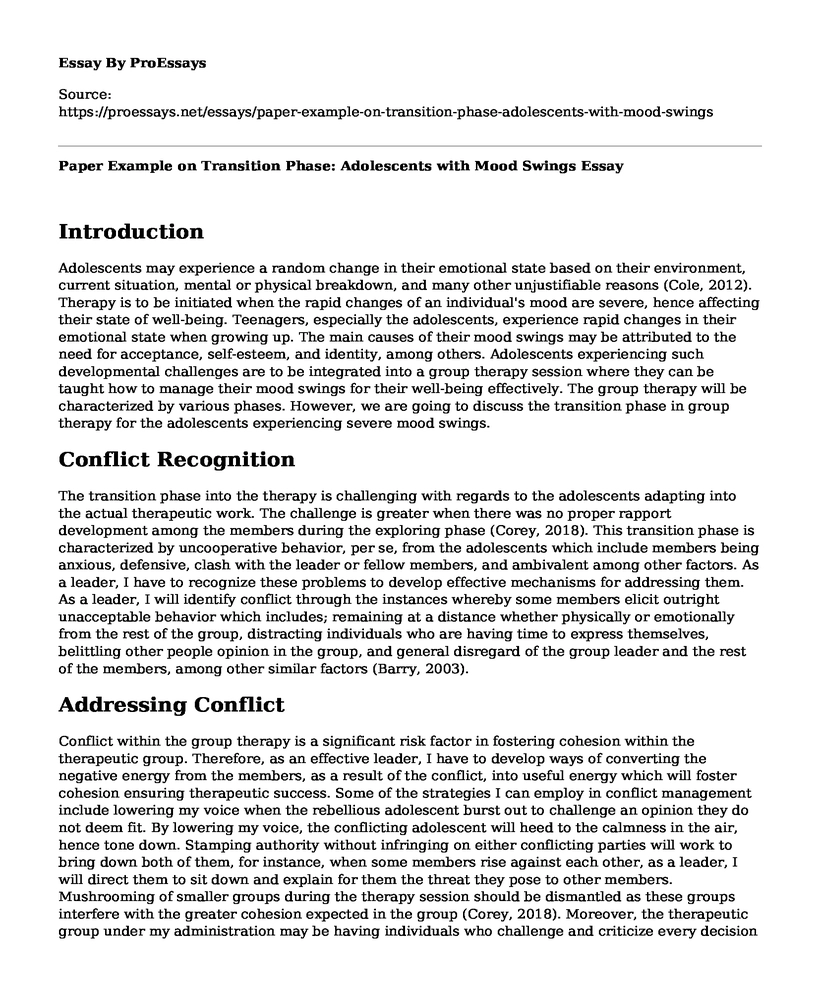Introduction
Adolescents may experience a random change in their emotional state based on their environment, current situation, mental or physical breakdown, and many other unjustifiable reasons (Cole, 2012). Therapy is to be initiated when the rapid changes of an individual's mood are severe, hence affecting their state of well-being. Teenagers, especially the adolescents, experience rapid changes in their emotional state when growing up. The main causes of their mood swings may be attributed to the need for acceptance, self-esteem, and identity, among others. Adolescents experiencing such developmental challenges are to be integrated into a group therapy session where they can be taught how to manage their mood swings for their well-being effectively. The group therapy will be characterized by various phases. However, we are going to discuss the transition phase in group therapy for the adolescents experiencing severe mood swings.
Conflict Recognition
The transition phase into the therapy is challenging with regards to the adolescents adapting into the actual therapeutic work. The challenge is greater when there was no proper rapport development among the members during the exploring phase (Corey, 2018). This transition phase is characterized by uncooperative behavior, per se, from the adolescents which include members being anxious, defensive, clash with the leader or fellow members, and ambivalent among other factors. As a leader, I have to recognize these problems to develop effective mechanisms for addressing them. As a leader, I will identify conflict through the instances whereby some members elicit outright unacceptable behavior which includes; remaining at a distance whether physically or emotionally from the rest of the group, distracting individuals who are having time to express themselves, belittling other people opinion in the group, and general disregard of the group leader and the rest of the members, among other similar factors (Barry, 2003).
Addressing Conflict
Conflict within the group therapy is a significant risk factor in fostering cohesion within the therapeutic group. Therefore, as an effective leader, I have to develop ways of converting the negative energy from the members, as a result of the conflict, into useful energy which will foster cohesion ensuring therapeutic success. Some of the strategies I can employ in conflict management include lowering my voice when the rebellious adolescent burst out to challenge an opinion they do not deem fit. By lowering my voice, the conflicting adolescent will heed to the calmness in the air, hence tone down. Stamping authority without infringing on either conflicting parties will work to bring down both of them, for instance, when some members rise against each other, as a leader, I will direct them to sit down and explain for them the threat they pose to other members. Mushrooming of smaller groups during the therapy session should be dismantled as these groups interfere with the greater cohesion expected in the group (Corey, 2018). Moreover, the therapeutic group under my administration may be having individuals who challenge and criticize every decision I make. However, as an effective leader, I will embrace these attacks and challenges as an opportunity for growth and respond to them honestly for the continuity of the group.
Conclusion
The transition phase is challenging for a group leader; hence the leader is required to rise to the occasion and counteract these challenges, keeping the therapeutic process on track. Effective leadership will be able to recognize and address the challenges posed, hence be able to convert the negative energy making the therapeutic process as pleasant for the members.
References
Barry, J. (2003). The Recognition and Management of Mood Disorders as a Comorbidity of Epilepsy. Epilepsia, 44, 30-40. doi: 10.1046/j.1528-1157.44.s4.4.x
Cole, M. (2012). Group dynamics in occupational therapy. Thorofare, NJ: SLACK Inc.
Corey, G. (2018). Theory & Practice of Group Counseling (9th ed.)
Cite this page
Paper Example on Transition Phase: Adolescents with Mood Swings. (2022, Aug 15). Retrieved from https://proessays.net/essays/paper-example-on-transition-phase-adolescents-with-mood-swings
If you are the original author of this essay and no longer wish to have it published on the ProEssays website, please click below to request its removal:
- Research Paper on Behavioural and Communicative Functioning of Children With Autism Spectrum Disorder
- Essay Sample on Tackling Stress: An Exercise in Mind-Boggling Research
- Essay on How Walt Disney Ruined Our Love Lives: The Impact on Modern Romantic Relationships
- New Moms: Dealing With Postpartum Depression & Prenatal Mood Disorders - Essay Sample
- Essay on Age-Related Deterioration: Understanding Aging Theories to Promote Quality Services for Older Adults
- Essay Example on CBT Therapy Plan: 8 Sessions to Positively Intervene Emotional Problems
- Psychopathy: Signs, Symptoms, Causes & Impacts - Free Essay Example







